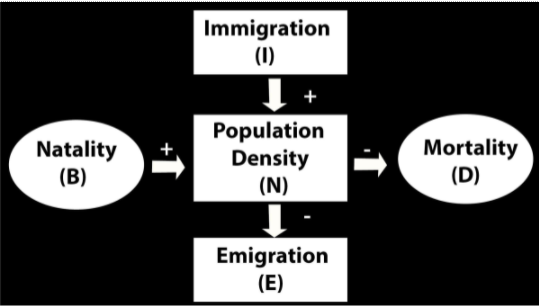
If in a population, natality is balanced by mortality then there will be.
(a) A decrease in population growth
(b) Zero population growth
(c) Increase in population growth
(d) Overpopulation
Answer
576.9k+ views
Hint: Natality refers to the number of births and hence causes an increase in the population while mortality is related to the number of deaths so it results in a decrease in the population. When balanced, their effects are nullified.
Complete answer:
If a population’s natality is balanced by mortality then there will be zero population growth.
Let's begin the explanation by understanding what is population density.
Population size is technically called 'population density.' It is represented by the letter 'N'. Whatever may be the overall reasons, the density of a population in a given habitat, during a given time is not constant. This happens due to changes in four basic processes. Two out of these four processes (natality and immigration) cause an increase in the population density, while the other two processes (mortality and emigration) result in a fall in population density.
Now let’s learn more about the terms natality and mortality.
-The total number of births during a given time in a population that is added to the existing density is called ‘natality.’
-The total number of deaths during a given time in a population is called ‘mortality’.
-The total number of individual species that have come into a habitat from elsewhere during the time under consideration, altogether account for 'immigration.'
-Emigration: The total number of individuals of a population who left the habitat and gone elsewhere during the time under consideration, account for 'emigration.'
Thus, if N is a population density at a time t, then it's the density at time t+1 is
${ N }_{ t+1 }\quad =\quad { N }_{ t }\quad +\quad \left\lceil \left( B+I \right) \quad -\quad \left( D+E \right) \right\rceil$
Here (B+E) are birth and immigrants, and
(D+E) are death and emigrants
You can see from the above equation that if in a population, natality is balanced by mortality then there will be zero population growth.
So, the correct answer is, (b) ‘zero population growth.’
Note: -In a population when natality is less than mortality and immigration is less than emigration, the population growth decreases.
-In a population when natality is more than mortality and immigration is more than emigration the population growth increases.

Complete answer:
If a population’s natality is balanced by mortality then there will be zero population growth.
Let's begin the explanation by understanding what is population density.
Population size is technically called 'population density.' It is represented by the letter 'N'. Whatever may be the overall reasons, the density of a population in a given habitat, during a given time is not constant. This happens due to changes in four basic processes. Two out of these four processes (natality and immigration) cause an increase in the population density, while the other two processes (mortality and emigration) result in a fall in population density.
Now let’s learn more about the terms natality and mortality.
-The total number of births during a given time in a population that is added to the existing density is called ‘natality.’
-The total number of deaths during a given time in a population is called ‘mortality’.
-The total number of individual species that have come into a habitat from elsewhere during the time under consideration, altogether account for 'immigration.'
-Emigration: The total number of individuals of a population who left the habitat and gone elsewhere during the time under consideration, account for 'emigration.'
Thus, if N is a population density at a time t, then it's the density at time t+1 is
${ N }_{ t+1 }\quad =\quad { N }_{ t }\quad +\quad \left\lceil \left( B+I \right) \quad -\quad \left( D+E \right) \right\rceil$
Here (B+E) are birth and immigrants, and
(D+E) are death and emigrants
You can see from the above equation that if in a population, natality is balanced by mortality then there will be zero population growth.
So, the correct answer is, (b) ‘zero population growth.’
Note: -In a population when natality is less than mortality and immigration is less than emigration, the population growth decreases.
-In a population when natality is more than mortality and immigration is more than emigration the population growth increases.

Recently Updated Pages
A man running at a speed 5 ms is viewed in the side class 12 physics CBSE

The number of solutions in x in 02pi for which sqrt class 12 maths CBSE

State and explain Hardy Weinbergs Principle class 12 biology CBSE

Write any two methods of preparation of phenol Give class 12 chemistry CBSE

Which of the following statements is wrong a Amnion class 12 biology CBSE

Differentiate between action potential and resting class 12 biology CBSE

Trending doubts
What are the major means of transport Explain each class 12 social science CBSE

Differentiate between homogeneous and heterogeneous class 12 chemistry CBSE

What is virtual and erect image ?

What is the Full Form of PVC, PET, HDPE, LDPE, PP and PS ?

The first microscope was invented by A Leeuwenhoek class 12 biology CBSE

Write any three uses of polaroids class 12 physics CBSE




